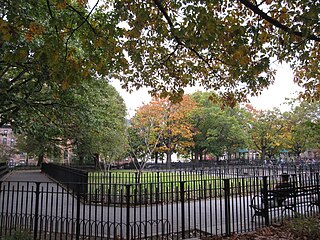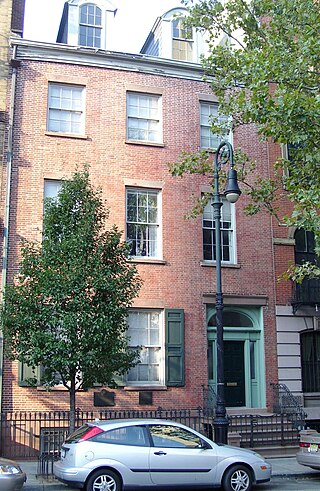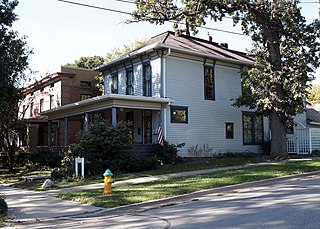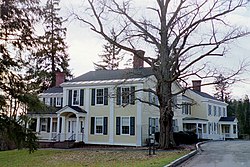
Clinton is a village in Oneida County, New York, United States. The population was 1,942 at the 2010 census, declining to 1,683 in the 2020 census 13% decline). It was named for George Clinton, the first Governor of New York.

Elihu Root was an American lawyer, Republican politician, and statesman who served as the 41st United States Secretary of War under presidents William McKinley and Theodore Roosevelt and 38th United States Secretary of State under Roosevelt. In both positions as well as a long legal career, he pioneered the American practice of international law. Root is sometimes considered the prototype of the 20th century political "wise man", advising presidents on a range of foreign and domestic issues. He also served as a United States Senator from New York and received the 1912 Nobel Peace Prize.

Clinton Hill is a neighborhood in north-central Brooklyn, a borough of New York City. It is bordered by the Brooklyn Navy Yard and Flushing Avenue to the north, Williamsburg to the northeast, Nostrand Avenue and Bedford–Stuyvesant to the east, St Marks Avenue and Prospect Heights to the south and southwest and Carlton Avenue and Fort Greene to the west.

Hamilton College is a private liberal arts college in Clinton, New York. It was originally established as the Hamilton-Oneida Academy in 1793 and later received its charter as Hamilton College in 1812, in honor of Alexander Hamilton, one of its inaugural trustees, following a proposal made after his death in 1804. Since 1978, Hamilton has been a coeducational institution, having merged with its sister school, Kirkland College.

Ulysses Simpson Grant III was a United States Army officer and planner. He was the son of Frederick Dent Grant, and the grandson of General of the Army and American President Ulysses S. Grant.

The Ulysses S. Grant Home in Galena, Illinois is the former home of Ulysses S. Grant, the Civil War general and later the 18th president of the United States. The home was designed by William Dennison and constructed in 1859 - 1860. The home was given to Grant by residents of Galena in 1865 as thanks for his war service, and has been maintained as a memorial to Grant since 1904.

The Benjamin Harrison Presidential Site, previously known as the Benjamin Harrison Home, is the former home of the 23rd president of the United States, Benjamin Harrison. It is in the Old Northside Historic District of Indianapolis, Indiana. Harrison's 16-room house was built from 1874 to 1875. It was from the front porch of the house that Harrison instituted his famous Front Porch Campaign in the 1888 United States presidential campaign, often speaking to crowds on the street. In 1896, Harrison renovated the house and added electricity. He died there in a second-story bedroom in 1901. Today it is owned by the Arthur Jordan Foundation and operated as a museum to the former president by the Benjamin Harrison Foundation.

The Morris–Butler House is a Second Empire-style house built about 1864 in the Old Northside Historic District of Indianapolis, Indiana. Restored as a museum home by Indiana Landmarks between 1964 and 1969, the American Civil War-era residence was the non-profit organization's first preservation project. Restoration work retained some of its original architectural features, and the home was furnished in Victorian and Post-Victorian styles. Its use was changed to a venue for Indiana Landmarks programs, special events, and private rentals following a refurbishment in 2013. Regular daily tours of the property have been discontinued.

The Santanoni Preserve was once a private estate of approximately 13,000 acres (53 km²) in the Adirondack Mountains, and now is the property of the State of New York, at Newcomb, New York.

The Hamilton Fish House, also known as the Stuyvesant Fish House and Nicholas and Elizabeth Stuyvesant Fish House, is where Hamilton Fish (1808–93), later Governor and Senator of New York, was born and resided from 1808 to 1838. It is at 21 Stuyvesant Street, a diagonal street within the Manhattan street grid, between 9th and 10th Streets in the East Village neighborhood of New York City. It is owned by Cooper Union and used as a residence for the college's president.

Kennicott Grove is an area of prairie and wooded lands that includes the home of John Kennicott (1802–1863) and his family, including his son Robert Kennicott (1835–1866). John Kennicott was an agriculturalist and a doctor. Robert Kennicott was a naturalist and an explorer, who founded the Chicago Academy of Sciences. The grove is 123 acres (0.50 km2) in size. It is located near the intersection of Milwaukee Ave. and Lake Ave. in Glenview, Illinois, in the United States. Kennicott Grove was declared a National Historic Landmark in 1976. The site is maintained by the Glenview Park District as The Grove National Historic Landmark or also The Grove, and contains a nature interpretive center, historic buildings, and nature trails.

The Davis and Elkins Historic District is a National Historic Landmark District on the campus of Davis & Elkins College in Elkins, West Virginia. It includes two mansions, the Senator Stephen Benton Elkins House (Halliehurst) and Graceland, that are separately listed on the National Register of Historic Places. A gate house and an ice house are also included in the district. These four structures are associated with the families of Henry Gassaway Davis (1823-1916) and Stephen Benton Elkins (1841-1911), who were dominating figures in the politics and economy of West Virginia in the late 19th century. It was declared a National Historic Landmark in 1998.

Liberty Hall, also known as the Governor William Livingston House, located on Morris Avenue in Union, Union County, New Jersey, United States, is a historic home where many leading influential people lived. It was documented by the Historic American Buildings Survey (HABS) in 1938. The house was added to the National Register of Historic Places as a National Historic Landmark on November 28, 1972, for its significance in politics and government. It is now the Liberty Hall Museum.

The Elihu Benjamin Washburne House, also known as the Washburne-Sheehan House, is a 1+1⁄2-story Greek Revival house located at 908 Third Street in Galena, Illinois. Constructed in 1844–45, the building was built for and owned by Elihu Benjamin Washburne, a prominent Galena lawyer who served in Congress during the American Civil War, and as Secretary of State and Minister to France under President Ulysses S. Grant, another famous Galenian. The Washburne House was added to the U.S. National Register of Historic Places in 1973.

Roosevelt Hall (1903–1907) is an immense Beaux Arts-style building housing the National War College on Fort Lesley J. McNair, Washington, DC, USA. The original home of the Army War College (1907–1946), it is now designated a National Historical Landmark (1972) and listed on the National Register of Historic Places (1972).

Harding Farm is a historic site west of the village of Clinton in Oneida County, New York, United States. It is located on New York State Route 233 and is situated 0.4 miles (0.6 km) south of the junction of NY 233 and New York State Route 412.

The Henry W. Baker House is located at 233 S. Main St. in Plymouth, Michigan. It was built by its original owner as a private home, but now houses commercial space. It was designated a Michigan State Historic Site in 1981 and listed on the National Register of Historic Places in 1982.

The Henry Wallace House is an historic building located in Des Moines, Iowa, United States. It was the home of Henry Wallace who was an advocate for agricultural improvement and reform. The house was listed on the National Register of Historic Places as a contributing property in the Sherman Hill Historic District in 1979 and it has been individually listed since 1993.

The Queens Campus or Old Queens Campus is a historic section of the College Avenue Campus of Rutgers, The State University of New Jersey in New Brunswick, New Jersey, in the United States.

























